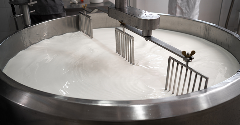News
US dairy exports see first half fall
8 Aug 2019USDEC has reported lost sales to China due to retaliatory tariffs and African swine fever, plus strong competition elsewhere from European and New Zealand suppliers, resulted in lower U.S. export volume in the first half of 2019.
Shipments of milk powders, cheese, butterfat, whey products and lactose were 1.0 million tons, down 14% from last year’s record pace. Exports of these major products to China were down 54%, while sales to other markets were up 5%.

Overall value of U.S. dairy exports reached $2.95 billion in the first half, up for the third straight year. Suppliers saw notable gains in sales value to Mexico, Southeast Asia, South Korea, Canada and South America, offsetting a large decline in sales to China.
Bright spots for the first half of the year included increased cheese exports; record whey and lactose sales to Southeast Asia; and record fluid milk/cream shipments.
Cheese exports in the first half of 2019 were 193,169 tons, up 4% from a year ago, and the most since 2014. U.S. suppliers posted record volumes to South Korea (+26%), Southeast Asia (+16%) and Central America (+28%), plus increased sales to the Middle East/North Africa (MENA) region (+16%). This offset declines in shipments to Mexico (-15%) and China (-46%).
Exports of nonfat dry milk/skim milk powder (NDM/SMP) failed to match last year’s record pace. First-half volume was 327,755 tons, down 15%. Volume was lower in all major markets, including top customers Mexico (-5%) and Southeast Asia (-10%). The United States lost share to European suppliers as the EU’s sizable public intervention stocks that had hung over the market for the past four years made its way to private hands selling the product at a discounted price.
U.S. suppliers also faced competition from New Zealand exporters, who sought to clear production from a record flush in 2018/19.
Suppliers partially compensated with increased whey sales to Southeast Asia (+5%, to a new record volume) and Mexico (+12%).
Dry whey exports in the first half were just 81,994 tons, down 33% and the lowest since 2004. Most of the decline came from China, but suppliers also saw sales reductions from Japan (-50%) and Southeast Asia (-15%).
Exports of whey protein concentrate (WPC) have increased as the year has progressed, but total volumes still trail last year by a third. China made up virtually all the shortfall, while other markets mostly matched or exceeded last year, including record sales to Mexico (+14%).
Shipments of modified whey (permeate) were the lowest first-half volume since 2012, falling 10% below last year’s pace. Suppliers were able to offset some of the lost sales to China with record exports to New Zealand (+154%) and Southeast Asia (+60%).
Whey protein isolate (WPI) volumes were up 9% in the first half, coming in just shy of the record 2015 pace. Volumes to Southeast Asia (+38%) and South Korea (+43%) were the most ever, and sales to Canada, the EU and even China also were above year-ago levels.
Lactose exports were 186,977 tons in the first half, down 11% from last year’s record pace, but still the second most ever. Sales to China were off 33%, and volumes to Japan (-13%) and New Zealand (-9%) were down as well. However, exports to Southeast Asia (+9%) were the most ever.
Exports of fluid milk/cream were up 16%, led by record volumes to Taiwan (our largest customer, up 32%) and Mexico (+8%), plus increased sales to Canada (+46%).
Shipments of milk protein concentrate (MPC) were higher for the third straight year, up 17% year-to-date. The majority of the gains came from a nearly four-fold increase in sales to Canada.
Exports of butterfat and whole milk powder (WMP) were each down more than 30% in the first half. Strong domestic use has made less butter available for export, while suppliers lost a key WMP market in China (-94%).
Sales of food preps (blends) were down 19% in the first half, with the lowest volume in 17 years. Most U.S. sales go to Canada, where volume was down 10%.
On a total milk solids basis, U.S. exports were equivalent to 14.1% of U.S. milk solids production in the first half of 2019. Over the previous five years, exports have averaged 14.7% of production.
Related news

Consumers dislike faba beans’ sensory profile
3 Jun 2024
Consumers display low acceptance of faba beans, with sensory properties such as bitterness a core concern, a study suggests. However, for product varieties such as cocoa-free chocolate, this attribute could prove to be a benefit.
Read more
Food scientists uncover new way to preserve nutrient and flavour quality
29 May 2024
Researchers have developed a method that guarantees food safety for low-moisture products, such as dried milk, while maximising quality by retaining vitamins, minerals, and flavours, they say.
Read more
FDA scrutinizes milk pasteurisation over HPAI risk
28 May 2024
The US Food and Drug Administration (FDA) is undertaking additional scientific research work to ensure that approved pasteurization processes are rigorous enough after retailer milk tests showed contamination from Highly Pathogenic Avian Influenza (HPA...
Read more
Magnum targets ice cream lovers’ moods with new flavours
2 May 2024
Unilever-owned Magnum has released a suite of “mood-inspired flavours” as the 2024 ice cream season kicks off. The offerings, marketed as the Magnum Pleasure Express, are Magnum's first foray into the “mood-food” category.
Read more
The eight global food trends shaping the future of dining
23 Apr 2024
Unilever’s Future Menu Trend 2024 report identifies the global food trends shaping the food service industry, providing insights into changing consumer preferences that could provide inspiration for packaged food and drink brands.
Read more
Report outlines how the US interfered with marketing restrictions on formula across the globe
18 Apr 2024
A recent investigative report by ProPublica unmasked the extensive interference by the US government in international regulations concerning the marketing of formula.
Read more
Ultra-processed food intake in South Africa at concerning levels, study suggests
19 Mar 2024
As South Africa considers introducing front-of-pack warning labels and strict marketing limits for unhealthy foods, research has found that low-income South Africans get around half of their calories from ultra-processed foods (UPFs) – “a cause for con...
Read more
India’s mithai market develops new ingredient and flavour profiles
18 Mar 2024
Mithai is a hugely popular dessert and sweet snack in India and manufacturers are experimenting with unique ingredients, new flavour combinations, and healthier versions to capture new audiences.
Read more
Unilever and Perfect Day’s animal-free dairy dessert: Is precision fermentation the future of dairy?
6 Mar 2024
Perfect Day, a precision fermentation dairy supplier, has partnered with Unilever's Breyers, a brand of ice cream and frozen dairy desserts, to launch Breyers lactose-free chocolate frozen dessert.
Read more
Macauba oil emerges as potential rainforest-friendly palm oil alternative
1 Mar 2024
Producers and researchers consider the rainforest-friendly credentials of Macauba palm oil and whether its sustainability credentials offer an opportunity to replace palm oil.
Read more